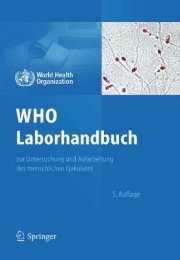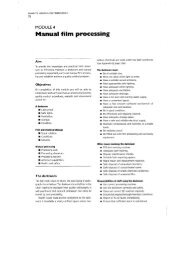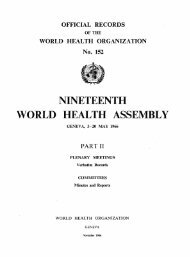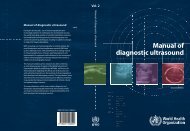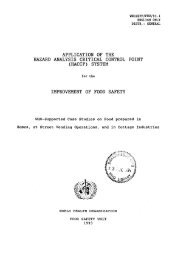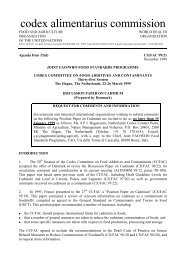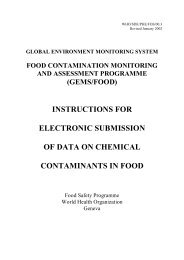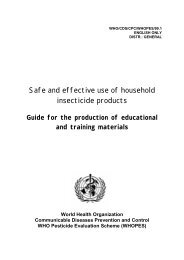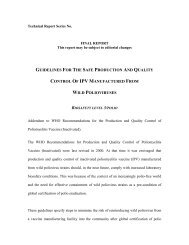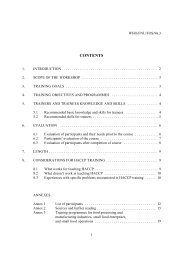WHO Drug Information Vol. 20, No. 4, 2006 - World Health ...
WHO Drug Information Vol. 20, No. 4, 2006 - World Health ...
WHO Drug Information Vol. 20, No. 4, 2006 - World Health ...
You also want an ePaper? Increase the reach of your titles
YUMPU automatically turns print PDFs into web optimized ePapers that Google loves.
<strong>WHO</strong> <strong>Drug</strong> <strong>Information</strong> <strong>Vol</strong> <strong>20</strong>, <strong>No</strong>. 4, <strong>20</strong>06<br />
Comparative studies are limited, but<br />
tolterodine has been included in a<br />
placebo-controlled trial of darifenacin.<br />
Unfortunately, a comparative analysis of<br />
the 15 mg dose of darifenacin was not<br />
carried out for all the outcomes.<br />
Darifenacin only achieved a statistical<br />
advantage over tolterodine for some<br />
outcomes if it was given at a daily dose of<br />
30 mg. Darifenacin’s selective action<br />
does not appear to give it a large clinical<br />
advantage.<br />
Article drawn from: The Australian prescriber.<br />
<strong>Vol</strong>ume 29, Number 5, October <strong>20</strong>06 at<br />
www.australianprescriber.com<br />
Reference<br />
1. Haab F, Stewart L, Dwyer P. Darifenacin, an<br />
M3 selective receptor antagonist, is an<br />
effective and well-tolerated once daily treatment<br />
for overactive bladder. Eur Urol<br />
<strong>20</strong>04;45:4<strong>20</strong>-9.<br />
Tigecycline for serious<br />
infections<br />
Australia – Tigecycline (Tygacil®)<br />
vials containing 50 mg lyophilised powder<br />
for reconstitution have been approved for<br />
complicated skin and soft tissue infections<br />
and complicated intra-abdominal<br />
infections.<br />
Tigecycline is structurally related to the<br />
tetracycline class of antibiotics and is a<br />
derivative of minocycline. It has broad<br />
spectrum in vitro activity against Grampositive,<br />
Gram-negative and anaerobic<br />
organisms and also tetracycline-resistant<br />
bacteria. Coverage includes multiresistant<br />
bacteria such as methicillin-resistant<br />
Staphylococcus aureus (MRSA) and<br />
vancomycin-resistant enterococci. Tigecycline<br />
has poor activity against Pseudomonas<br />
species.<br />
Tigecycline is not absorbed from the gut<br />
so it must be administered by slow<br />
Safety and Efficacy Issues<br />
intravenous infusion. It is extensively<br />
distributed in the body and has a serum<br />
half-life of 40 hours. The tissue half-life is<br />
not known. Tigecycline is not extensively<br />
metabolised and so most of the drug is<br />
excreted unchanged in the urine and<br />
faeces.<br />
The safety and efficacy of tigecycline<br />
were evaluated for the treatment of skin<br />
and skin-structure infections from pooled<br />
data of two trials totalling 1116 hospitalized<br />
adults. Soft tissue infections, abscesses<br />
and infected ulcers were the<br />
most common type of infections in these<br />
patients. Cure rates for tigecycline and<br />
vancomycin/aztreonam were similar in<br />
trials. Both treatments were equally<br />
effective in patients with underlying<br />
comorbidities such as diabetes mellitus<br />
and peripheral vascular disease (1).<br />
The safety and efficacy of tigecycline<br />
were also evaluated for the treatment of<br />
complicated intra-abdominal infections,<br />
such as complicated appendicitis.<br />
Similar levels of drug efficacy were<br />
reflected in patients who were microbiologically<br />
evaluable (2). Although tigecycline<br />
has in vitro activity to multidrug<br />
resistant bacteria, there were limited data<br />
in these trials to support its use in patients<br />
with these infections. However,<br />
tigecycline was effective at eradicating<br />
MRSA in 25 out of 32 patients with<br />
complicated skin infections (1).<br />
The most common drug-related adverse<br />
events reported by tigecycline recipients<br />
were nausea and vomiting. Overall there<br />
were 30 deaths in the tigecycline groups<br />
and 18 deaths in the control groups. One<br />
death of a tigecycline recipient, after<br />
septic shock, was possibly related to the<br />
study drug.<br />
Tigecycline is not recommended for<br />
pregnant women or children. Tetracycline<br />
class effects, such as photosensitivity,<br />
may also occur in patients taking tigecycline.<br />
259



